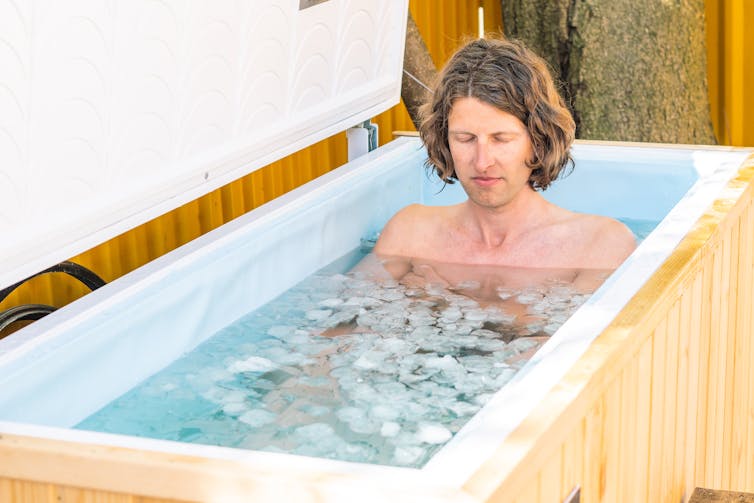Immersion in cold water is definitely an activity that divides people – some love it others hate it. But many now practice it weekly or even daily in the belief that it’s good for their mental and physical health.
Cold water therapy, as it has come to be known, can take the form of outdoor swimming – in lakes, rivers or the ocean – cold showers or even ice baths. It has been used for a while by sportspeople as a way to reduce muscle soreness and speed up recovery time – with people typically spending about ten minutes after exercise in cold water that’s about 10-15°C.
Cold water has also been used to help treat symptoms of depression, pain and migraine. Indeed, there are many accounts of how cold water therapy has changed lives, cured broken hearts and helped people during difficult times.
While many studies have shown benefits linked to ice baths and post-exercise recovery, research from 2014 found there could be a placebo effect going on here.
Indeed, research into the potential benefits of cold water therapy or outdoor swimming is in its early stages, but what is clear is that cold water immersion can have potentially harmful effects on the human body.
Cold water risks
With any activity that’s intended for therapeutic effect, the minimum requirement is that it “does no harm”. But we can’t say that about cold water – as it comes with a lot of risks.
At the moment, the science to fully support cold water as a therapy is not available and it’s not yet known if there is a certain duration or temperature that works best. But what we do know is that less is definitely more when it comes to cold water immersion. In other words, going in colder water or staying in for longer is not better for you. In fact, it can have just the opposite effect.
In the UK, the water temperatures in natural environments are roughly between 10-28°C in the summer, falling to between 0-7°C in the winter. And it’s important to point out that open water temperatures lag behind air temperatures, so in April when the air temperature can be warm the sea temperature, even on the south coast, is likely to be below 10°C.
It might seem that when it comes to cold water therapy, showers and baths are a less hazardous option because you have greater control in terms of temperature and exposure time compared with open water. But due to the colder temperatures showers and ice baths can achieve and the solitary nature of the immersion they still pose significant risks.
One of the little-known problems associated with cold water immersion is what’s known as non-freezing cold injury. When we are exposed to the cold, it’s normal for the hands and feet to feel very cold or numb and they may tingle or be painful on rewarming. For most people, these symptoms are transient, with normal sensations returning within a few minutes. But for those with non-freezing cold injury, these symptoms (pain, altered sensation and cold sensitivity) can persist in the affected areas for many years due to nerve and blood vessel damage.
It’s caused by prolonged exposure to cold and wet conditions such as those seen in the trenches during wars – hence its nickname “trench foot”. It’s not just the military who are susceptible though, cases have been recently reported in rough sleepers and those undertaking water sports.
Another issue is that it’s not known how cold is too cold when it comes to cold water immersion and non-freezing cold injury. There are also a lot of differences in the way our individual bodies respond to cooling. For example, those from African and Caribbean backgrounds seem to be more susceptible to non-freezing cold injury – so the risks from cold exposure will vary between different people.
Encouragingly though, one study from 2020 with cold water swimmers indicates that although they may have cold sensitivity, this was not associated with damage to the blood vessels in the skin.
Cold water tips
So if you are wanting to give cold water therapy a go, here are some things to consider:
• Check with your GP beforehand to make sure it’s safe for you to do.
• Make sure you’re not alone and the water is safe – if outdoors consider tides, currents, waves, underwater obstacles, pollution and jelly fish.

Always make sure you’re careful when immersing yourself in cold water, don’t stay too long and look after yourself afterwards. Michele Ursi/Shutterstock
• Plan how you’re going to get in and out of the water safely (remember that your muscles won’t work as well when you’re cold and you may not be able to feel with your hands and feet).
• Know how you’re going to get warm afterwards - make sure you have towels, dry clothes, windproofs, a hot drink and somewhere to shelter. Don’t drive or cycle until you have completely warmed up.
• Only stay in cold water for a short period of time, get out before you experience numbness, pain or shivering.



 Eli Lilly’s Weight-Loss Pill Nears Fast-Track FDA Approval as Profits Surge on Global Demand
Eli Lilly’s Weight-Loss Pill Nears Fast-Track FDA Approval as Profits Surge on Global Demand  Innovent’s Xinermei Intensifies Weight-Loss Drug Battle in China
Innovent’s Xinermei Intensifies Weight-Loss Drug Battle in China  U.S. Reveals 2026 Medicare Star Ratings: Aetna, UnitedHealth Lead in Quality Scores
U.S. Reveals 2026 Medicare Star Ratings: Aetna, UnitedHealth Lead in Quality Scores  Major Drugmakers Slash U.S. Prices and Sell Directly to Patients Amid Trump’s Push for Affordable Medicines
Major Drugmakers Slash U.S. Prices and Sell Directly to Patients Amid Trump’s Push for Affordable Medicines  Bayer’s Stroke Drug Achieves Breakthrough Trial Results, Boosting Market Confidence
Bayer’s Stroke Drug Achieves Breakthrough Trial Results, Boosting Market Confidence  Merck Nears Acquisition of Cidara Therapeutics at Significant Premium
Merck Nears Acquisition of Cidara Therapeutics at Significant Premium  FDA Adds Fatal Risk Warning to J&J and Legend Biotech’s Carvykti Cancer Therapy
FDA Adds Fatal Risk Warning to J&J and Legend Biotech’s Carvykti Cancer Therapy  Novo Nordisk and Eli Lilly Lower Prices for Weight-Loss Drugs Amid U.S. Agreement
Novo Nordisk and Eli Lilly Lower Prices for Weight-Loss Drugs Amid U.S. Agreement  Trump and Merck KGaA Partner to Slash IVF Drug Costs and Expand Fertility Coverage
Trump and Merck KGaA Partner to Slash IVF Drug Costs and Expand Fertility Coverage  Cogent Biosciences Soars 120% on Breakthrough Phase 3 Results for Bezuclastinib in GIST Treatment
Cogent Biosciences Soars 120% on Breakthrough Phase 3 Results for Bezuclastinib in GIST Treatment  Eli Lilly Becomes First Pharma Giant to Hit $1 Trillion Amid Soaring Weight-Loss Drug Demand
Eli Lilly Becomes First Pharma Giant to Hit $1 Trillion Amid Soaring Weight-Loss Drug Demand  Trump Hints at Major Autism Announcement, Raises Questions on Tylenol Link
Trump Hints at Major Autism Announcement, Raises Questions on Tylenol Link  Canada Loses Measles-Free Status After Nearly 30 Years Amid Declining Vaccination Rates
Canada Loses Measles-Free Status After Nearly 30 Years Amid Declining Vaccination Rates  Trump Administration to Launch Autism Initiatives Targeting Acetaminophen Use and New Treatment Options
Trump Administration to Launch Autism Initiatives Targeting Acetaminophen Use and New Treatment Options 






























